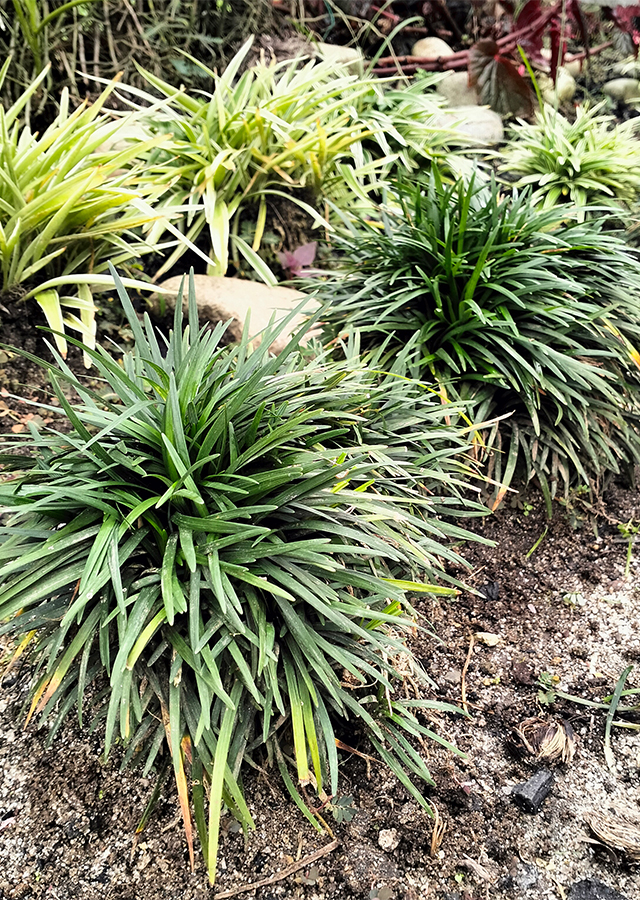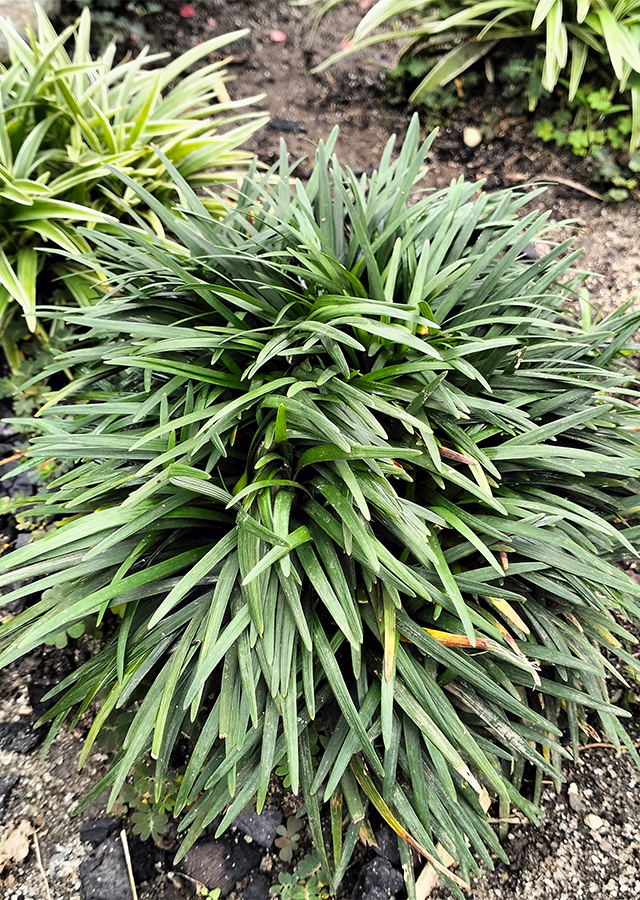Mondo Grass
Ophiopogon japonicus (Thunb.) Ker Gawl.
Asparagaceae
Location in our garden
Shading Area



Synonym
Convallaria japonica Thunb.
Flueggea japonica (Thunb.) Rich.
Mondo japonicum (Thunb.) Farw.
Habitus
Herbaceous. An evergreen, stemless, tuft-forming stoloniferous, short grass-like perennial herb that grows to 30 cm tall.
Part Used
Leaves
Roots
Rhizome
Growing Requirements
Need Shade
Habitat
Coastal
Mountains
Terrestrial
Overview
Ophiopogon japonicus is native to East Asia – China, India, Japan, Vietnam, Korea, Taiwan and the Philippines. Genus name comes from the Greek, ophis, meaning snake and pogon meaning beard. Specific epithet means of Japan in reference to native habitat. Gyoku-ryu’ is a dwarf mondo grass cultivar that forms a dense carpet. The plant is often cultivated as a medicinal plant, and is also ornamentally grown for its tufts of grass-like leaves as a ground cover. Tuberous root is edible and eaten as a famine food. In Taiwan, root is used as food ingredient and as functional food in China often as a substitute for ginseng.
Vernacular Names
Herbe Aux Turquoises (French), Mughetto giapponese (Italian), Japanischer Schlangenbart (German), Convalaria (Spanish), Ryu-no-hige (Japanese), Mai men dong (Chinese), Mạch Ðông (Vietnamese), Langigit (Philippines), Jobnipmaekmundongajaebi (Korean).
Agroecology
Occurs in shady places in lowland and foothills, forests, mossy forests, dense scrub in ravines, moist and shady places on slopes and along streams and cliffs. Grows well in full sun or partial shade in well-drained, moist sandy or sandy loam soils. As a decorative plant for freshwater aquaria, but because it is not a true aquatic plant, it can live for a few months underwater before it dies. While hardy to temperatures of about – 20 °C when dormant in winter outdoors in normal soil, when kept fully submerged, it requires water temperatures of 18–25 °C.
Morphology
- Roots - aromatic, sweet and mucilaginous, fibrous, large stolons with tuberous roots. Stolons are creeping and slender, roots moderately thick, usually with tuberous part near middle or tip.
- Leaves - simple, basal, sessile, fasciculate, linear, generally 15–50 cm long and 2–4 mm wide, 3–7 parallel veined, margin serrulate. They are dark green above and pale glaucous beneath. Scape is 6–15 (−27) cm, much shorter than leaves.
- Flower - inflorescence in axillary racemes, 1–20 cm long, several to more than 10 flowered with lanceolate white bracts. Flowers are solitary or paired, usually pendant; pedicel 34 mm. Tepals 6-lobed, white or pale lilac, lanceolate, 5 mm long and 2 mm wide. Filaments are very short; anthers 2.53 mm long and lanceolate. Style is narrowly conical, 4 mm long, moderately thick, basally widened.
- Fruit - subglobose to ellipsoid–globose, pea-sized, blue-black berries, 5–9 mm in diameter.
Cultivation
Generative propagation is by seeds, and vegetative propagation is by division.
Chemical Constituents
Homoisoflavonoids (ophiopogonanone C, ophiopogonanone D, ophiopogonone C, ophiopogonanone E, and ophiopogonanone F, and many others), sesquiterpene glycoside (ophioside A), monoterpene glycoside (ophiopogonol), spirostans (ophiogenin, and others), ophiopogonol, essential oil, steroidal saponins.
Traditional Medicinal Uses
- In China, traditionally used as anti-inflammatory. Also, as tonic and tranquilizer, treatment of cough, insomnia, diabetes, constipation, and diphtheria, sicca-associated disorders and cardiovascular disease.
- Essential oil used for treatment of sore throat, cough, heart disease.
- It is used as antiseptic for healing of mouth sores.
- It is used to stimulate milk in nursing mothers and diabetes treatment.
Part Used
Reference Sources
- Health Benefits Times. (2021). Health benefits of Ophiopogon (Mondo Grass). https://www.healthbenefitstimes.com/ophiopogon/. 11-01-2023.
- Kew Royal Botanic Garden. (No date). Plants of the world Online: Ophiopogon japonicus (Thunb.) Ker Gawl. https://powo.science.kew.org/taxon/urn:lsid:ipni.org:names:429781-1#synonyms. 11-01-2023.
- Lan, Shen, et al. (2013). Chemical constituents from the fibrous root of Ophiopogon japonicus, and their effect on tube formation in human myocardial microvascular endothelial cells. Fitoterapia, Vol.85: pg 57-63. Also available: https://www.sciencedirect.com/science/article/abs/pii/S0367326X12003528
- Missouri Botanical Garden. (No date). Ophiopogon japonicus 'Gyoku-ryu'. https://www.missouribotanicalgarden.org/PlantFinder/PlantFinderDetails.aspx?kempercode=s960. 11-01-2023.
- National Park of Singapore. (2021). Flora & Fauna Web: Ophiopogon japonicus (Thunb.) Ker Gawl. https://www.nparks.gov.sg/florafaunaweb/flora/8/5/8542. 11-01-2023.
- Stuartxchange. (2019). Philippine Medicinal Plants: Mondo grass. http://www.stuartxchange.org/MondoGrass.html. 11-01-2023.

